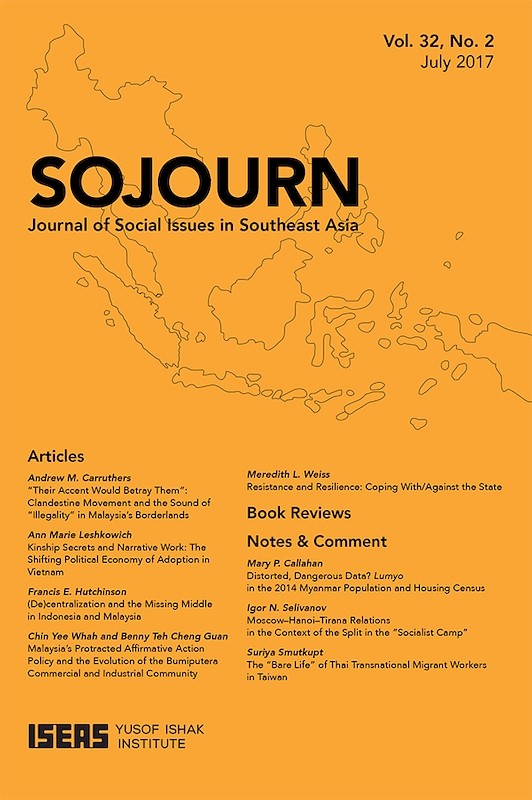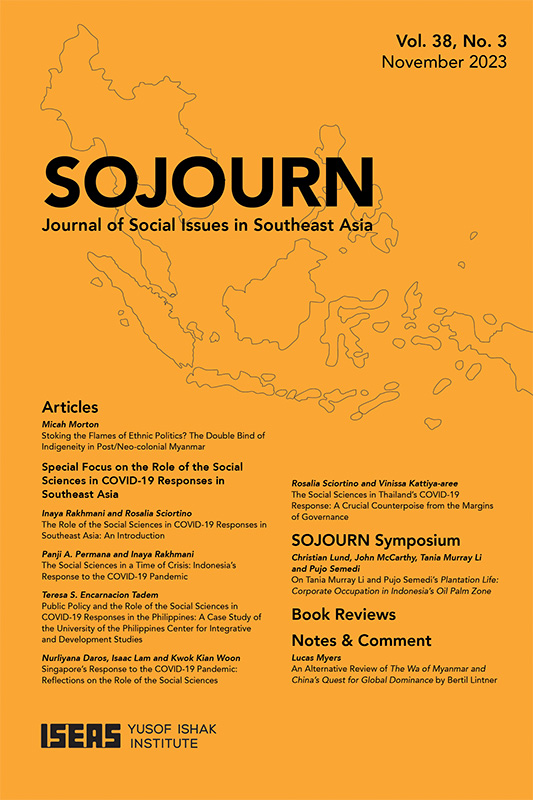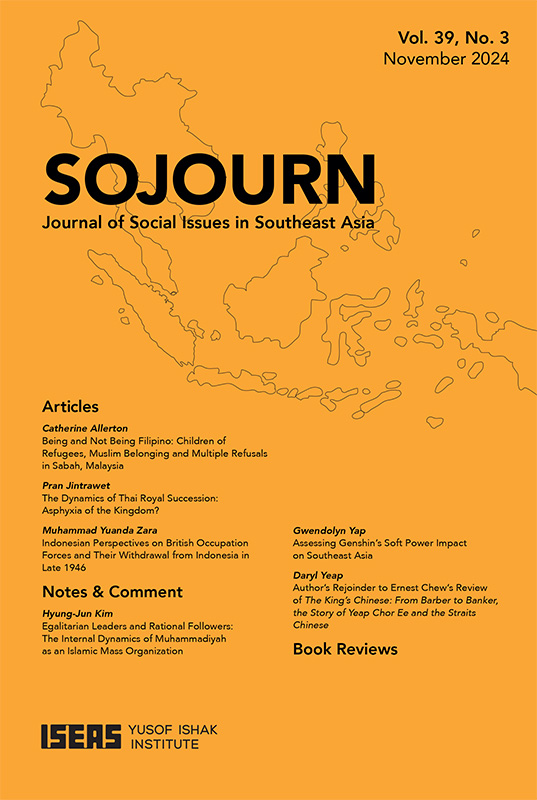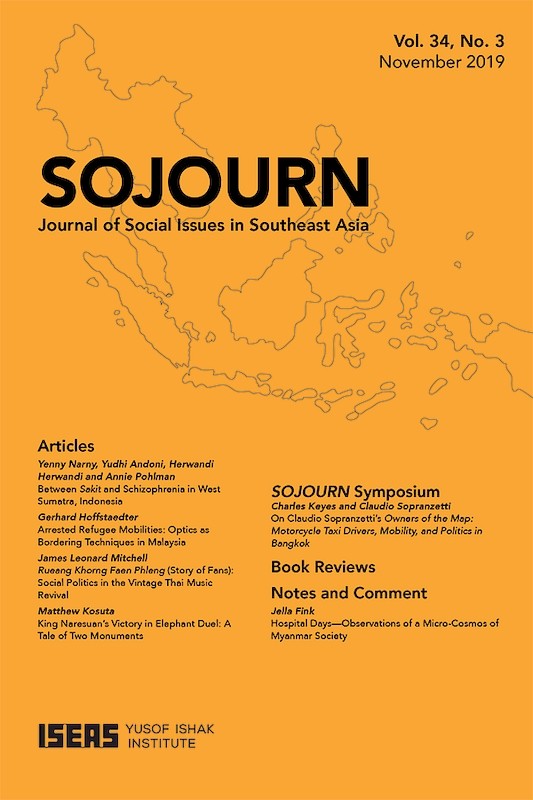SOJOURN: Journal of Social Issues in Southeast Asia Vol. 35/3 (November 2020)
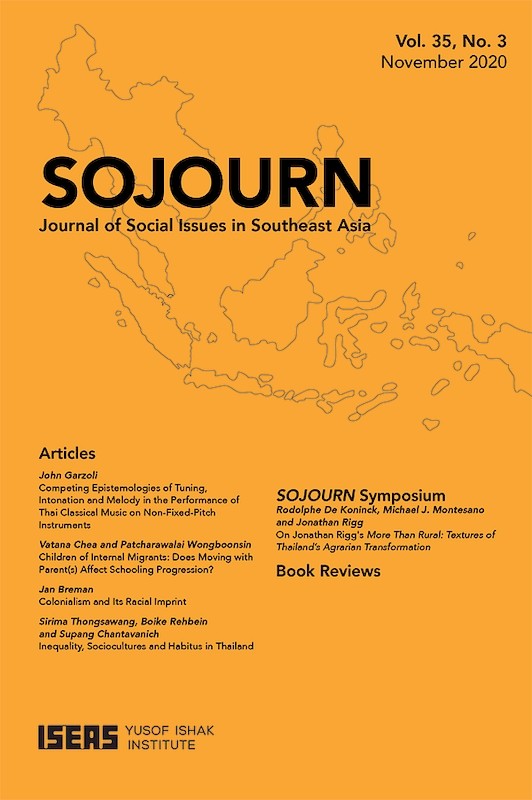
Su-Ann Oh, editor
Date of publication:
November 2020
Publisher:
ISEAS – Yusof Ishak Institute
Number of pages:
161
Code:
SJ35/3
Contents
-
SOJOURN: Journal of Social Issues in Southeast Asia Vol. 35/3 (November 2020)
[Whole Publication, ISSN: 17932858] -
Preliminary pages
- ARTICLES
-
Competing Epistemologies of Tuning, Intonation and Melody in the Performance of Thai Classical Music on Non-Fixed-Pitch Instruments, by John Garzoli, author see abstractDifferences between Thai fixed-pitch and non-fixed-pitch musical practice have been described, but there has been no accepted explanation of these differences in relation to the accepted Thai tuning theory. This theory maintains that the Thai scale is equidistant, but it was not formulated to explain the practices and concepts of musicians who sing or play non-fixed-pitch instruments. The absence of an explanation for these practices is attributed to the tendency among scholars to accept assumptions about tuning that were developed for European rather than Thai music. This article is relevant to Southeast Asian studies as it deals with the problem of imported extrinsic theory displacing indigenous explanatory models.
-
Children of Internal Migrants: Does Moving with Parent(s) Affect Schooling Progression?, by Vatana Chea, Patcharawalai Wongboonsin, authors see abstractUsing the 2011 Cambodia Rural Urban Migration Project, we reexamine the effect of parental migration on the long-term educational progress of children who have accompanied their parents to urban areas by comparing such children with those left behind in rural areas. We use a measurement that captures schooling disruption effect and allows for the possibility that being a migrant child also depends on school quality in the neighbourhood. The fixed-effect estimator is applied to eliminate family characteristics shared among siblings such as parental resources and perceptions towards education. Regression shows that migrant children are in a more disadvantageous situation, relative to children left behind, as a result of the migration of their parents.
-
Colonialism and Its Racial Imprint, by Jan Breman, author see abstractTo meet the huge demand for a workforce in the plantation belt that arose on Sumatra’s East Coast, coolies were initially recruited from Malaya and later from China and Java. They were held captive by a labour contract subjecting them to penal sanctions. An official but undisclosed report documented a wide range of atrocities to discipline workers found ‘slothful’ or resisting. My monograph, Taming the Coolie Beast (1989), featured this report, but was challenged by some reviewers as biased and moralistic. In a riposte, I argued that ‘the coolie scandal’ should be contextualized in the wider setting of colonial rule and its objectives. Resistance to the forced production of agrarian commodities led colonial wisdom to blame the peasantry of indolence. A more polished veneer of this myth suggested that the indigenous population was driven by social rather than economic needs. Institutionalized in legislation, the racist imprint of colonialism insisted on fixing a colour bar. The so-called Dutch ‘ethical policy’ of the early twentieth century promised welfare for the people, referred to as ‘natives’ in discriminatory colonial jargon, but was not implemented.
-
Inequality, Sociocultures and Habitus in Thailand, by Sirima Thongsawang, Boike Rehbein, Supang Chantavanich, authors see abstractThis paper studies social inequality in contemporary Thailand on the basis of a critical reading of Pierre Bourdieu’s sociology. It argues that pre-capitalist social structures combine with a capitalist structure of social classes to form a peculiar double-faced hierarchy. The study discerns seven habitus types; one being rooted in the village, two in the <i>sakdina </i>structure, three in capitalism and one cutting across the dividing line between <i>sakdina </i>and capitalist structures. The paper draws on sixty-two qualitative interviews that were conducted and interpreted on the basis of a methodology inspired by the documentary method.
- SOJOURN SYMPOSIUM
-
On More Than Rural: Textures of Thailand’s Agrarian Transformation by Jonathan Rigg, by Rodolphe De Koninck, Michael J Montesano, Jonathan Rigg, authors
- BOOK REVIEWS
-
BOOK REVIEW: Bomb Children: Life in the Former Battlefields of Laos, by Leah Zani , by Oliver Tappe, author
-
BOOK REVIEW: Tales of Southeast Asia’s Jazz Age: Filipinos, Indonesians and Popular Culture, 1920–1936, by Peter Keppy, by Adil Johan, author
-
BOOK REVIEW: Performing the Arts of Indonesia: Malay Identity and Politics in the Music, Dance and Theatre of the Riau Islands, edited by Margaret Kartomi, by Timothy P Barnard, author
-
BOOK REVIEW: Islam, Humanity, and Indonesian Identity: Reflections on History, by Ahmad Syafii Maarif, translated by George A. Fowler, by Michael Laffan, author
-
BOOK REVIEW: After the Tsunami: Disaster Narratives and the Remaking of Everyday Life in Aceh, by Annemarie Samuels, by Judith E. Bosnak, author
-
BOOK REVIEW: Hard at Work: Life in Singapore, edited by Gerard Sasges and Ng Shi Wen, by Suhaila Zainal Shah, author
-
BOOK REVIEW: Blood Work: Life and Laboratories in Penang, by Janet Carsten, by Bo Kyeong Seo, author
-
BOOK REVIEW: Modern Times in Southeast Asia, 1920s–1970s, edited by Susie Protschky and Tom van den Berge, by Roger Casas, author

